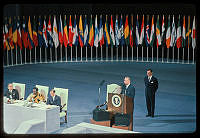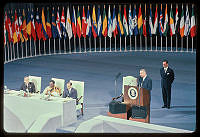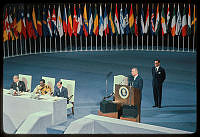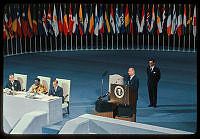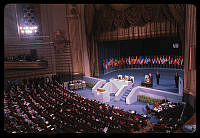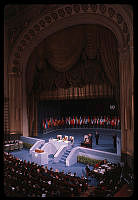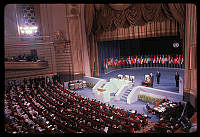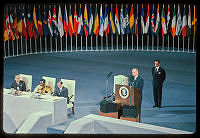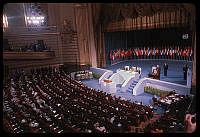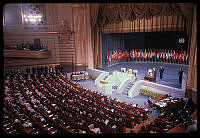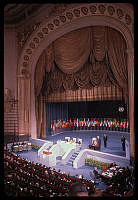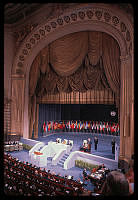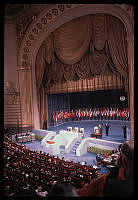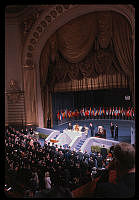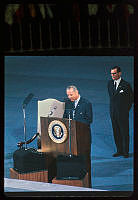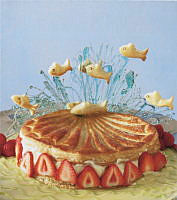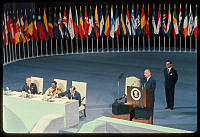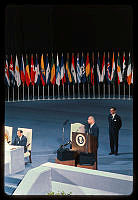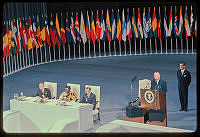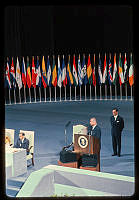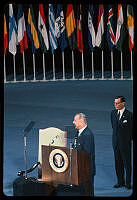Photographs of the Lincoln White House
Copyright © White House Historical Association. All rights reserved under international copyright conventions. No part of this article may be reproduced or utilized in any form or by any means, electronic or mechanical, including photocopying, recording, or by any information storage and retrieval system, without permission in writing from the publisher. Requests for reprint permissions should be addressed to books@whha.org
Abraham Lincoln assumed the office of president of the United States on March 4, 1861, an innovative period for photography. He was the first president to be photographed extensively and is thought to have sat for as many as thirty-six photographers on sixty-six occasions. 1 His White House also became the subject matter for a growing number of photographers. Their work enables us to see the Executive Mansion at an important time in our nation’s history.
By the 1860s, photography had undergone several important developments. The most significant change was the ability to produce paper prints from glass negatives. Photographic images no longer had to be unique but could be reproduced for a larger audience. Average people could now afford to have their portraits made at a studio and to buy images of celebrities and scenic sites for their own collections.
Early photographic formats, such as daguerreotypes, ambrotypes, and tintypes, were unique, or one-of-a-kind, images exposed on nonpaper supports. A daguerreotype, for example, was a positive image made directly on a sheet of copper, plated with a highly polished coating of silver. It could appear as either a positive or a negative depending on the angle it was tilted. The only way it could be copied was by rephotographing the original. Subject to corrosion and abrasion, the fragile daguerreotypes were displayed behind glass in small hinged cases.2
Prints on paper, on the other hand were easier to produce and display. Made from glass plate negatives, they could be copied endlessly and were subsequently more affordable. Glass negatives were prepared using the wet collodion process, a technique that was popular from 1855 until it was replaced in the 1880s by the gelatin dry-plate negative process. In a dark room, a glass plate was covered with collodion, a syrupy liquid, and a silver nitrate solution and then placed into a special holder for protection. If the photographer was outside the studio, this step was undertaken in a specially constructed tent or covered wagon. Timing was important because the exposure had to be made while the plate was still damp. The subject was posed and placed into focus before the plate holder was inserted into the camera. A protective shield and the lens cap were then removed to expose the plate. The exposure could take approximately fifteen to thirty seconds. To avoid blurriness, studios often used props or headrests to help the sitter remain still. The exposed plate then had to be developed in a darkroom and washed. When the negative was dry, it was placed on a sheet of light-sensitive paper and exposed to the sun to create a positive print. The paper most commonly used from the mid-1850s until the early twentieth century was coated with albumen, an emulsion of egg white, and brushed with light-sensitive silver salts.3
Multilens cameras were developed that could expose several images simultaneously on a glass plate. With a four lens camera, where two pairs of images were created, each pair was stereoscopically related. When printed, the images could be mounted as two stereographs or separated as four smaller cartes de visite. A large number of photographs could be produced quickly from original negatives.4
Cartes de visite and stereographs were perhaps the most popular photographic forms available during the 1860s. A carte de visite was a photograph mounted onto a card that was similar in size to a calling card, approximately 2¼ by 4 inches. A stereograph had two nearly identical images mounted side-by-side. When seen through a special viewer, a three-dimensional effect was achieved. Any antique shop today is likely to have for sale “stereo slides.” Perhaps millions were made, many by amateurs, and among the amateurs were many women.
Cartes de visite were acquired to such an extent that special albums were sold to house the collections. Prints of family members were displayed along with Civil War heroes, political leaders, and scenic views. The Lincoln family was no exception and had an album while living in the White House. Their album contained views of Washington, D.C., including the White House, Lafayette Square, the War Department, the Treasury Building, the Capitol, the Post Office Department, and the Smithsonian Institution.5
Determining the photographer of a particular image can be very difficult. Many were simply not identified. At that time, it was not uncommon for publishers or major studios to buy the negatives from other photographers and print and publish them as their own. E. & H. T. Anthony & Company, for example, was a New York publisher and photographic supply firm that employed many photographers and purchased negatives from outside sources. Images published under the Anthony logo rarely name the actual camera operator. Mathew Brady’s studio, while it was managed by Alexander Gardner, did make a special agreement with Anthony. The publisher was furnished with negatives to be mass-produced and distributed, for which Brady was paid a fee and given a credit line. Operators working for Brady, however, were not recognized. Photographs made by his employees were credited to Brady himself.6
Photographs of the White House from this period predominately feature the exterior of the building. Lighting interior spaces presented many challenges for photographers, and there are only a few images that show the interior of the house prior to the later 1860s.7 The photographs selected for this article are from the White House collection unless otherwise noted. The dates of some examples are not known, but they were selected because they reflect the appearance of the Executive Mansion while Lincoln was president.
Mathew B. Brady
With a gallery already established in New York, Mathew Brady opened a studio in Washington, D.C., in 1849 in hopes of making daguerreotype portraits of important Americans. The National Photographic Art Gallery, located on Pennsylvania Avenue between Fourth and Sixth Streets, NW, was not profitable, however, and closed after a few months. Brady returned to Washington in 1858 and tried again with Brady’s National Photographic Art Gallery on Pennsylvania Avenue near Seventh Street in the top three floors of Gilman’s Drugstore. This venture, initially managed by photographer Alexander Gardner, met with great success. It was established at a time when the innovative wet collodion process was being used and photographs were more affordable. Bad business deals and financial problems would eventually cause Brady to close his New York studio and declare bankruptcy in 1872. His Washington business did not close until 1881.8
Among his many accomplishments, Brady is also remembered for his efforts to document the Civil War. Under his name, teams of camera operators in specially equipped wagons were sent on location to photograph military life, battlefields, and the war’s aftermath. Brady himself appeared in several of the images.9













